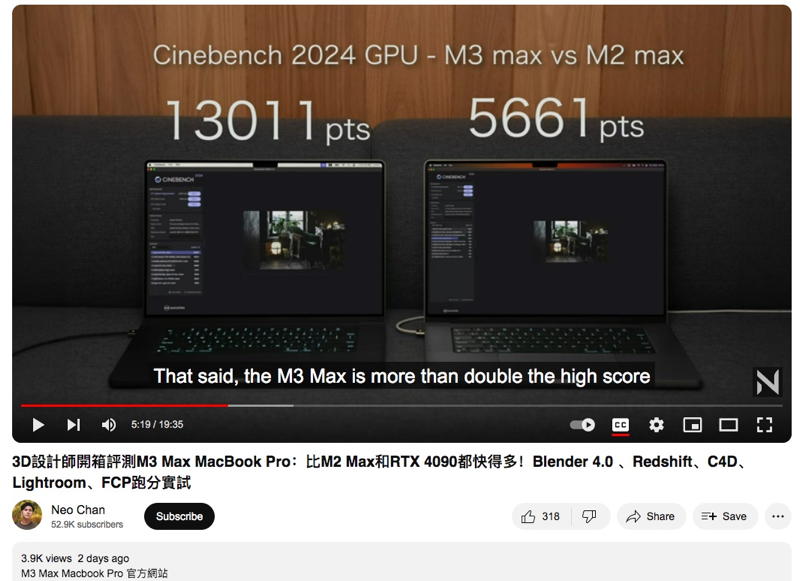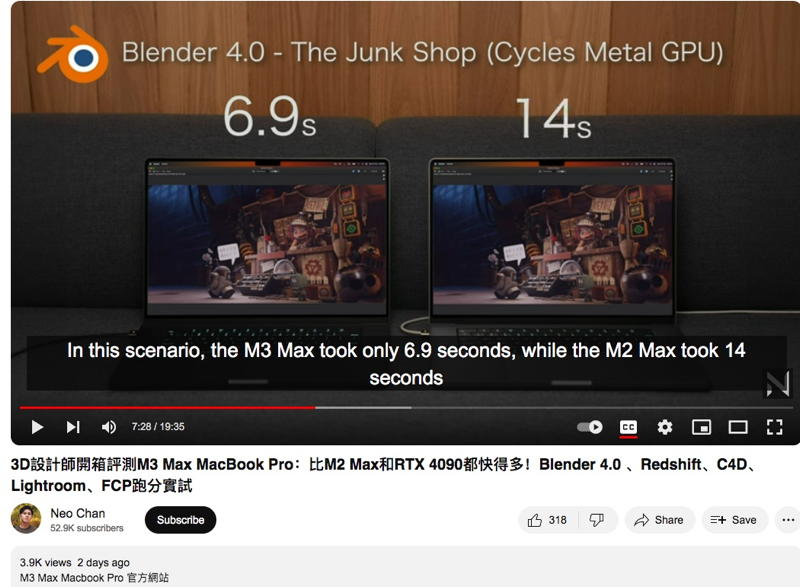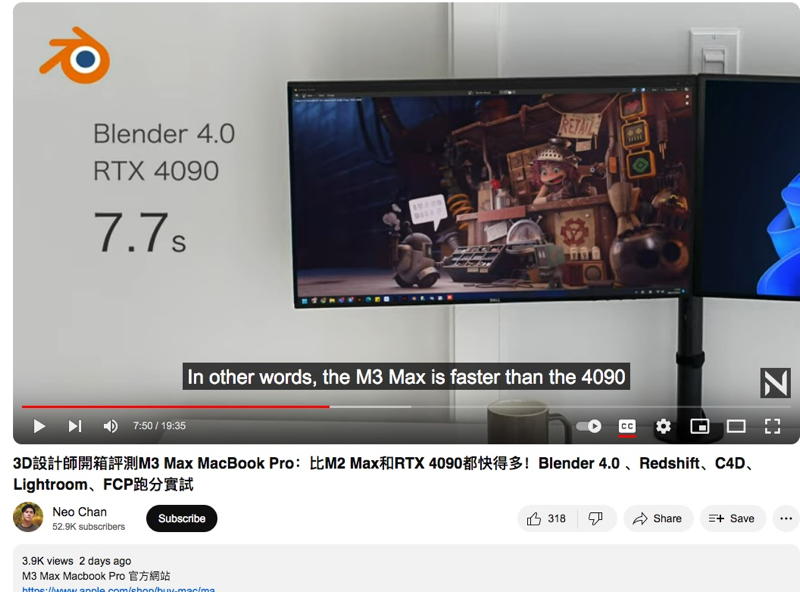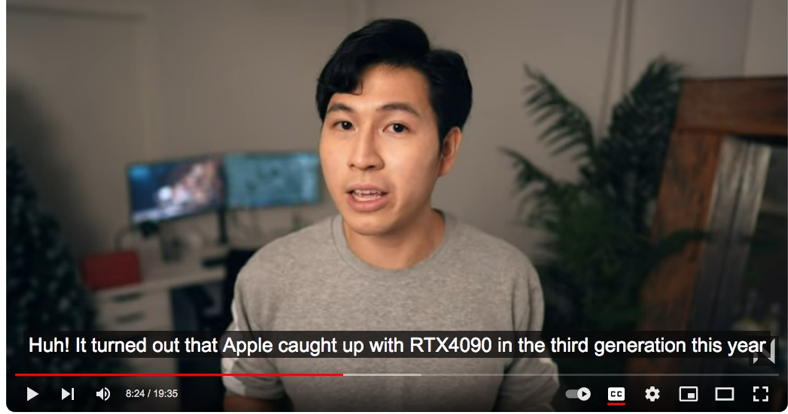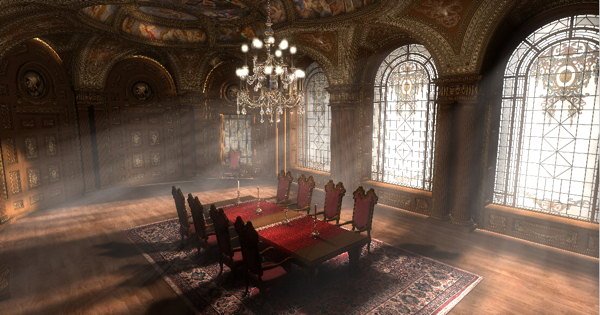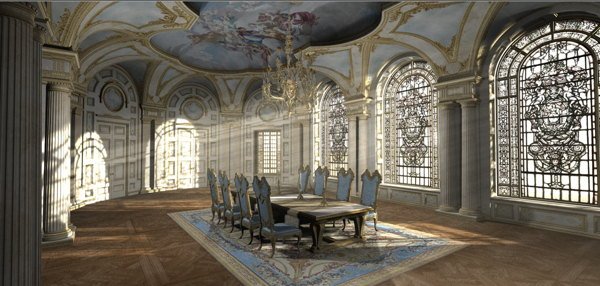
Jay60p
Members-
Posts
169 -
Joined
-
Last visited
Content Type
Profiles
Forums
Articles
Everything posted by Jay60p
-
For anyone doing 3D modeling, animation, rendering, the M3 is a major Update due to the new ray tracing acceleration. I decided against an M2 Studio to wait for next year’s M3 Studio: PCs with a Nvidia GPU card were always faster than a Mac for rendering 3D animation, for the same reasons PCs are faster in gaming. But now Neo Chan’s video demonstrates that his M3 laptop is roughly equal to his PC with a RTX4090 for 3D work. Here it was faster in rendering a Blender scene: The point is, M3 is much faster than M2 for 3D work. For those who want to do 3D in OSX it looks like a game changer.
-
Yes, I would go with a fluid head. If, like me, you are using it at home and not professionally, you don’t need to spend Thousands for the ultra heavy duty sachtlers etc Today I would consider something like this: https://www.bhphotovideo.com/c/product/1220489-REG/e_image_eg05a2_two_stage_aluminum_tripod_with.html/reviews Or a head like this https://www.bhphotovideo.com/c/product/1676168-REG/magnus_fbvh_500_video_head_with.html/reviews Or a Manfrotto rated for the weight of your camera. I’ve used a Manfrotto 3063 mini fluid head for 20+? Years. It is still as smooth as new. It does smooth pans with a 500mm & X2 telephoto and an X-T3. I shot the live motion of the moon with it, still locks solid. You would want a tripod with a bowl base for leveling, otherwise you’ll have to adjust the leg lengths. I’d never go back to a pan/tilt head.
-
Now it is a surprise - DPReview is closing
Jay60p replied to Marcio Kabke Pinheiro's topic in Cameras
They are going to Petapixel. -
That is an impressive bit of research! So it was announced back in 2010 that Cypress developed the Alexa sensor: "December 20, 2010 09:00 AM Eastern Time Cypress’s Industry-Leading CMOS Image Sensor Portfolio Designed Into State-of-the-Art ARRI ALEXA Digital Movie Camera SAN JOSE, Calif.--(BUSINESS WIRE)--Cypress Semiconductor Corp. (Nasdaq:CY) today announced that a CMOS image sensor from its Image Sensor Business Unit has been designed into the state-of-the-art, 35 mm ALEXA digital motion picture camera from ARRI..." From other articles, I was under the impression that the existence of third party sensor designer was not known. Still, what I find surprising about onsemi’s announcement (and prompted my post) is that the “third party” is not an Asian based company such as Sony etc. Neither USA (or Belgium!) would have occurred to me.
-
https://www.onsemi.com/company/news-media/press-announcements/en/onsemi-imaging-technology-enables-next-era-of-digital-cinematography "PHOENIX – Sept. 14, 2022 – onsemi (Nasdaq: ON), a leader in intelligent power and sensing technologies, today announced it developed the customized high-end CMOS sensor for ARRI’s ALEXA 35 camera." “All digital ARRI cameras—starting with the first ARRIFLEX D-20 in 2005, followed by the first ALEXA delivered in June 2010 up to the ALEXA 35 introduced this year—are based on CMOS sensors jointly developed with onsemi,” said Walter Trauninger, managing director and head of business unit Camera Systems at ARRI.
-
I just took a quick look at the CineD review. Very nice. But what I found more interesting was the latest user comment By a Mr. Burkhart, apparently a professional who owns an Alexa. https://www.cined.com/fujifilm-x-h2s-lab-test-rolling-shutter-dynamic-range-and-exposure-latitude/ And speaking of Alexa, here is an article which suggests an unknown 3rd party designed the new Alexa 35 sensor: https://ymcinema.com/2022/07/18/arri-chief-color-scientist-alev-4-wasnt-developed-by-arri/
-
What I means is, you also see it as a compression issue? As you say, "there must be some purpose to the chroma smoothing other than preserving bandwidth for the luma channel" which we may never know. Ultimately only Fuji engineers know the reasons, and they never answer any posts here.
-
Thanks for that detailed response! I believe every word you said, but I still don’t know what you meant by “the reason is known”. Have you come to a conclusion?
-
Got it! It’s not color science, not NR, it’s compression. (The missing red leaves) My apologies if you posted about compression already. As my brother would say “Just hit me in the head!” Differing Compression levels explain both my indoor low complexity/high detail Cr shots, and your outdoor high complexity/low detail Cr very neatly, as well as my high complexity foliage shot yesterday - it looks like yours. (My earlier indoor tests were during winter time). Basically, when large amounts of detail must be discarded Fuji decided to smooth the reds more than Canon. Maybe this allows for more green or luminance detail for any chosen data rate. NOTE: For people reading forums who are shopping for a family camera, all the new cameras are great. You can safely ignore everything we say. We are all crazy.
-
Postscript: My wife tried reading my last post. She didn’t get very far. She said we’re all crazy. No doubt, She’s right.
-
Okay, RGB may be constructed from YCbCr, but I don’t find reds only affected in small detail areas, they are equally affected in large color fields. I spent too much time shooting tests with tiny red details, assuming the reds were being muted by chroma noise reduction as suggested in other posts. The chroma noise reduction is not to blame, in fact I found it extremely effective in the Fuji Cr without blurring detail. I studied Fuji jpg stills (also originally YCbCr?) in the app GIMP (the only GUI app that would extract YCbCr components that I could find). The contrast in the Fuji Cr component extract, displayed in B&W, was much lower than in the Canon Cr, giving it that misty washed-out look compared to the Canon Cr, but everything was still visible. There was no detail blurring, edges were sharp. No red items missing compared to the Canon. In fact, for green screen I much prefer the noise reduction In the Fuji. The edges of objects against a green screen were sharp and extremely clean, compared to much more noise in the green areas of the Canon Cr component. Of course, the Canon T2i is an older, cheaper, and lower resolution camera so I am not too surprised. But lost or blurred details in the Fuji Cr, I could not find. Only lower red saturation in the full color shot. And I also looked at Fuji RAW stills. I saw the dark reds were still lighter than the Canon and looked pretty much the same in red detail resolution & saturation as the jpegs. There were slight differences in the RAW between two different apps, just to add to the confusion! The Fuji video Cr files you have shown - of the wooded areas with the red leaves - appear very cloudy and nearly devoid of any detail, which is what appeared so bizarre & useless to me. Probably because they were nearly monochromatic compared to my test shots. We are not looking at the same types of files, and we're using different apps - You are using video and I am using jpeg & raw stills, for whatever that is worth. My jpeg Cr’s definitely show detail, So I’ll admit the Cr was not completely useless. If there is loss of red detail specific to video, I can suggest comparing a Fuji jpeg still to a video frame Of the exact same shot with lots of small multi-colored items, but I am done and I leave that for someone else to enjoy!
-
In that case, perhaps a custom LUT could adjust the Fuji dark reds to a darker richer red, closer to the Canon look. Beyond my abilities unfortunately.
-
Months ago I did extensive testing comparing my X-T3 color to my Canon T2i. I finally came to two conclusions, different from my last post. 1) I find the Cr channel completely useless for evaluating the chroma resolution or any other color quality of the X-T3. It is quite bizarre and completely misleading. Instead, study the usual RGB channels which appear completely normal and are as detailed as the actual full color photo. There is no red resolution being lost in the Red RGB like there appears to be in the Cr channel. I’m guessing the Cr channel is useless for image manipulation too, which may be why it was so hard to find an App which would display it. 2) The Canon had always showed more saturation in the darker reds compared to the X-T3. So I went and studied the shot comparisons between cameras at the Imaging Resource Comparometer: https://www.imaging-resource.com/IMCOMP/COMPS01.HTM Select the “Still Life 400” samples for X-T3 and any other camera to compare the same scene. In the X-T3 samples, The dark reds in the cloth on the left side appear lightened and/or slightly desaturated compared to all the other brands, not just Canon. This happens in solid color fields, not just red spots like foliage. Why does the X-T3 lighten/desaturate dark reds? I’m guessing the face is the most important image for Fuji’s color science. Perhaps the Fuji engineers discovered that this could downplay skin blemishes, which are often of a darker red color than the rest of the skin. In any case the good news is this: I checked Fuji’s online specifications for the X-H2S. And guess what, there is a provision for a setting Labeled “Smooth Skin Effect”, listed right after “Color chrome Blue : Strong, Weak, Off”. The actual settings are blank at the moment for the smooth skin effect. In future firmware there may be an “off” setting available. Maybe then those faint red leaves will appear in the foliage. https://fujifilm-x.com/global/products/cameras/x-h2s/specifications/
-
Exactly. Which is why I’m still looking for demos that show how the zoom behaves under various conditions. Such as: Aperture wide open vs stopped down, auto ISO/shutter/aperture vs. manual, slow zooms vs. fast, manual focus ring behavior etc. Since I never use auto focus, funky AF will not be a deal breaker for me. I expect the Fuji-made video that I linked to above shows it working under it’s best conditions, and it looks fine. But I expect there will be some limitations compared to a true cinema zoom, due to the focus/zoom/aperture control by wire. So waiting for more tests. Then I will see if I can work around the limitations. And please all you vloggers, I could care less how IBIS looks holding the camera at arm’s length and pointing it at my head. I’ve never done that and never will. (Two hands & the Ninja walk!)
-
Yes, need more footage from people who know what they are doing. For example, only one demonstration of the new 18-120 zoom specifically seems to show parfocal zooming when in manual focus: It needs to stay in focus with AF off, otherwise any AF camera with an AF zoom could be called "parfocal", (until the AF jumps, and then it isn't.) All the other Youtube demos I've seen obviously have the autofocus on, which shows occasional small vibrations in the image as the focus-by-wire motors are activated. Same with the old exposure stepping. It is in all the other youtube demos except this one. Need more reliable demos.
-
Enjoyed seeing the Prophet 600 mentioned, bought mine in 1986 and it still works fine. Today, sorry to see the news on the passing of Dave Smith, the man who invented MIDI, and the Prophet. https://www.npr.org/2022/06/07/1103569627/remembering-dave-smith-inventor-of-midi-and-the-prophet-5-synthesizer
-
Yes! If the descriptions turn out true in September, I’m getting the lens this fall. “…minimal focus breathing, stepless aperture control, and constant F4 aperture. Pull focus, make precise adjustments to iris, or change focal length without causing any noticeable distractions to the recorded footage.” All depends on what is “noticeable” to you. But no doubt will be a huge improvement over the present exposure-stepping zooms. Twice the zoom range and 1/3rd the cost of the Fuji cinema zooms, with auto focus. https://fujifilm-x.com/en-us/products/lenses/xf18-120mmf4-lm-pz-wr/ Works with X-T3. X-T4, X-S10 with firmware coming in Sept. “…the first lens to be designed in ‘collaboration between FUJINON Optics and FUJIFILM X Series engineers” https://www.dpreview.com/news/3492623346/fujifilm-xf-18-120mm-f4-lm-pz-wr-lens-is-parfocal-weather-sealed-and-will-cost-just-899
-
I shot jpegs at highest resolutions, at ISO 800. I pixel-peeped at 100% scale. I did not use video frames, video from the T2i is only 1080p and rather soft. I was able to use the same lenses on both cameras, Super-Takumars with M42 adapters. But, this issue needs more tests with low contrast mixed colors, I’ve think that’s where the small color details may get muted, mistakenly treated as noise. So I’m not bothering to post my shots showing how well the chroma NR works with medium to high contrast colors, I think that is already obvious to any Fuji user. No, we need to complain to Fuji about this foliage issue. Attila Bakos’ Cr component images show that Fuji needs to give us control over the amount of chroma NR, same as luminance NR. Landscape photography needs it, if nothing else. There should be an option of balancing color noise vs. color detail. A chroma NR setting of -4 to +4 would neatly solve this problem. Or even “On/Off” would be better than nothing. And we should not have to shoot RAW (if that comes in the X-H2) to get around this issue.
-
Here is another free GUI app to view Y Cb Cr: https://www.gimp.org/ Use the drop down menu COLORS / COMPONENT / EXTRACT COMPONENT, and then there is another drop down menu to select the type of component to view, including Y, Cb, Cr. Alternately there is also COLORS / COMPONENT / DECOMPOSE. Must admit I am finding it difficult to see any loss of red details or color blurring comparing my X-T3 to my Canon T2i. But so far I've shot indoor subjects only. No wonder it took 4 years to notice!
-
Concerning 8K & Apple headsets, forget about future-proofing, poor choice of words. Basically I like the idea of surrounding my full field of vision with video I shot myself. It’s an old idea, Omnimax theaters were doing it years ago with a huge half-circle dome screen covering 180 degrees of your vision. IMAX is just a big flat screen. Think planetarium dome night sky shows. With an 8K camera & 8K headset, it should be trivially easy to experiment With your own equivalent of Omnimax. This would be of more interest to the hobbyists here, doing their own projects. But I should have waited on posting about this, its off-topic & it’s too early yet. The Apple headset won’t be here for about year and the specs are not published. As far as “VR” that needs needs signing in on Facebook/Meta (Oculus), or anywhere else, I’ll have nothing to do with It.
-
I had nearly the same reaction with the newer Canon T2i and Fuji X-T3 compared to my older Fuji S1 Pro, concerning skin tones. In every other way the new cameras blow it away, but of all the cameras I’ve used the S1 Pro still has the most amazing skin tones. I still look at 8X10’s framed on the wall and marvel at the color in my kid’s portraits, shot with only 3MP resolution that look perfectly sharp. The S1 Pro always had a slight green cast to the image, and we know that that is also common in Arri cameras. But just adding green in the X-T3 does not match it. Some people say it is due to the unique CCD chip that Fuji had developed. I have no idea. I would rate the Canon and X-T3 skin tones as excellent, the S1 Pro as excellent+. https://www.dpreview.com/products/fujifilm/slrs/fuji_s1/specifications
-
I had been thinking shooting 8K for 4K/2K was useful for special purposes. Such as unmanned cameras covering a live event, and selecting the region of interest later. Or clean greenscreen composites. Here’s another: cropping into 8K as a way of lens shifting to adjust for perspective, as done in large format view cameras. Again, a special situation, not standard procedure. But here is a possible case for “standard procedure” 8K: future-proofing for “full field of view” displays, such as the Apple VR headset, and other as yet unknown future full visual field projection technology. I think such technology is inevitable. “One feature that seems almost certain given the plethora of leaks is the MR headset’s dual 8K displays. At 7680 x 4320 resolution, that’s four times as many pixels as a 4K screen and significantly more pixels than any other commercially available device.” ….https://www.techradar.com/news/apple-vr-headset To be prepared for VR & other future surround use, in 8K I would shoot a wider angle view than necessary, keeping the usual main action in the center “2k or 4K area” of the frame, and cropping it for standard TV & projection use, for now. Later, for wider field displays, I’d have the original 8K master with the extra “surround” image area. This would not be difficult for my family/travel/nature subjects since there is no limitations due to lighting, sets etc. Remember the small central “standard” field of view that some Omnimax films started with? Then the movie would expand out to the full field of vision of the entire Omnimax dome screen, for dramatic effect. Will the entire last century of films look “small” to future generations? I have no specific plans to get an 8K camera in the near future, the above is just conjecture, food for thought. But I am looking forward to a good hi-res 3D headset, I hope Apple pulls it off.
-
Right now Stonemason's models are on sale 55% off, 65% if 3 or more, which makes them about $15 each. Some of his models can use the free DAZ Studio "Bridge to Unreal Engine" (or Unity or Blender etc) translation. Stonemason is the best modeler at DAZ for 3D exterior scenes, from historical to futuristic. These sales are brief.
-
For highly detailed & inexpensive virtual sets, check out DAZ 3D. I rendered these with a DAZ model by Jack Tomalin (with two different texture sets), imported to Maxon Cinema 4D. Its a great way to experiment with lighting setups: Stonemason is another great DAZ modeler for virtual interiors/exteriors: https://www.daz3d.com/the-streets-of-venice These models are generally less than $50 and are getting more detailed every year. Lately I’ve been looking at low cost motion capture systems. Anyone tried the Perception Neuron 3 system? - $2,400 https://www.neuronmocap.com/perception-neuron-3-motion-capture-system
-
Silly me. My great grandson will only have to tell his A.I. to analyze the files and program an app for playback. Might take a few seconds.

